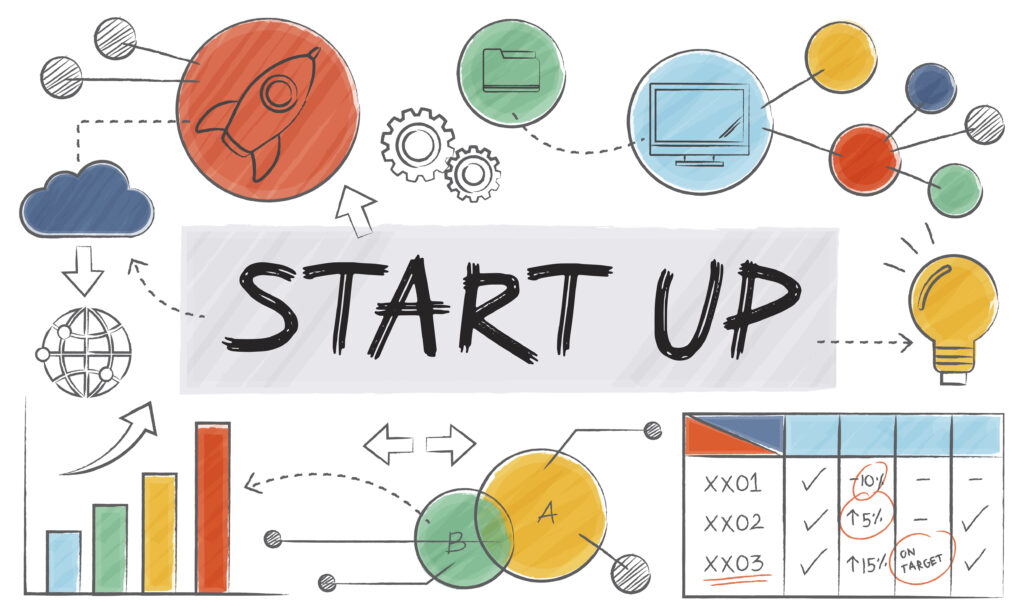- Home
- /
- Entrepreneurship
- /
- Intrapreneurship for Innovation in Corporations
Introduction
In the dynamic landscape of business, where tradition meets transformation, corporate entrepreneurship, or intrapreneurship, has emerged as a compelling force. Intrapreneurs are the unsung heroes within large organizations—individuals who channel their entrepreneurial spirit to drive innovation and cultivate growth from within the corporate framework. This blog aims to explore the nuances of corporate entrepreneurship, shedding light on its significance, challenges, and the impact it has on shaping the future of businesses.
What is Corporate Entrepreneurship?

Corporate entrepreneurship, often referred to as intrapreneurship, involves individuals within a large organization taking on entrepreneurial roles to identify, develop, and implement new ideas and projects. Intrapreneurs operate within the established structure of a corporation, leveraging resources, infrastructure, and support systems to drive innovation and create value.
Key Features of Corporate Entrepreneurship

Innovative Thinking
At the core of intrapreneurship lies a mindset of innovative thinking. Intrapreneurs challenge the status quo, question existing processes, and seek novel solutions to problems. This creative and forward-thinking approach is essential for introducing new products, services, or processes within the corporate environment.
Risk-Taking and Initiative
Intrapreneurs are willing to take calculated risks and seize opportunities. Unlike traditional corporate employees, they proactively identify gaps, inefficiencies, or untapped markets and take the initiative to propose and implement solutions. This proactive approach to risk-taking is a hallmark of intrapreneurial behavior.
Resource Utilization
Unlike external entrepreneurs who start with a clean slate, intrapreneurs work within the constraints and resources of the existing organization. Effectively utilizing available resources, both human and material, is a crucial aspect of intrapreneurship. This may involve repurposing existing assets or collaborating with different departments to achieve goals.
Adaptability and Resilience
Intrapreneurs navigate the complexities of corporate structures, facing resistance, bureaucracy, and at times, skepticism. The ability to adapt to changing circumstances and persevere in the face of challenges is a key trait of successful intrapreneurs. Their resilience ensures that innovative projects withstand the inevitable hurdles encountered in a corporate environment.
Benefits of Corporate Entrepreneurship

Continuous Innovation
Intrapreneurship fosters a culture of continuous innovation within organizations. By encouraging employees to think creatively and take ownership of new initiatives, companies can stay ahead of the curve, adapting to market changes and technological advancements.
Talent Retention and Motivation
Providing employees with opportunities to act as intrapreneurs can enhance job satisfaction and motivation. The prospect of working on innovative projects and seeing the direct impact of their efforts can be a powerful motivator, leading to increased retention of top talent.
Competitive Edge
Organizations that embrace intrapreneurship gain a competitive edge in the market. The ability to swiftly respond to emerging trends, capitalize on new opportunities, and adapt to customer demands positions them as agile and forward-thinking players in their respective industries.
Difference between Intrapreneurship and Entrepreneurship

Entrepreneurship and intrapreneurship are two distinct concepts that revolve around the spirit of innovation and business creation. While both involve taking risks and driving change, they differ in their context, scope, and the organizational setting in which they occur. Here’s a breakdown of the key differences between entrepreneurship and intrapreneurship:
| Entrepreneurship | Intrapreneurship | |
|---|---|---|
| Context and Setting | Entrepreneurship typically refers to the process of starting a new business or venture from scratch. Entrepreneurs are individuals who identify opportunities, mobilize resources, and take on the financial and operational risks associated with creating a new business entity. | Intrapreneurship, on the other hand, occurs within the confines of an existing organization. Intrapreneurs are employees who exhibit entrepreneurial characteristics by driving innovation, creating new products or services, and taking risks, all within the established structure of a larger company. |
| Ownership and Risk | Entrepreneurs often bear the full financial and personal risks associated with their ventures. They may invest their own capital, seek external funding, and navigate the uncertainties of the market with a high level of autonomy. | Intrapreneurs operate within the safety net of an established organization. While they still take risks and innovate, the financial risks are typically borne by the company. Intrapreneurs leverage existing resources, infrastructure, and support systems. |
| Innovation and Creativity | Entrepreneurs are free to pursue their vision and bring completely novel ideas to life. They have the flexibility to create and shape a business based on their own vision and insights. | Intrapreneurs innovate within the context of the existing organization. Their creativity is often directed toward improving or expanding existing products or services, developing new market strategies, or addressing specific challenges within the company. |
| Autonomy and Control | Entrepreneurs have full control over their ventures, making decisions about the direction of the business, the allocation of resources, and the overall strategy. Autonomy is a defining feature of entrepreneurship. | Intrapreneurs operate within the organizational structure, and their level of autonomy can vary. While some organizations empower intrapreneurs with considerable decision-making authority, others may have more hierarchical structures that limit autonomy. |
| Scale and Impact | Entrepreneurs aim to build independent, scalable businesses. The impact of entrepreneurship extends beyond the individual entrepreneur, potentially influencing entire industries or markets. | Intrapreneurs contribute to the growth and innovation of an existing organization. The impact is internal, driving improvements and expansion within the boundaries of the company. |
| Motivation | Entrepreneurs are often motivated by a desire for independence, the pursuit of a personal vision, and the potential for financial rewards. The drive to build something from the ground up is a significant motivating factor. | Intrapreneurs are motivated by a combination of factors, including a passion for innovation, a desire to make a positive impact within the organization, and the opportunity to contribute to the company’s success without the full burden of entrepreneurial risk. |
In summary, while both entrepreneurship and intrapreneurship involve innovation, risk-taking, and a proactive approach to creating value, the key distinction lies in the organizational context. Entrepreneurs build new ventures from the ground up, often with full ownership and autonomy, while intrapreneurs drive innovation within the existing framework of a larger organization, leveraging its resources and support structures. Both play crucial roles in shaping the business landscape, each contributing to the dynamic evolution of industries in its own unique way.
Key Examples of Corporate Entrepreneurship

Intrapreneurship examples abound, showcasing how employees within established organizations can drive innovation, create value, and contribute to the company’s growth. Here are some notable examples of intrapreneurship:
Google’s 20% Time
One of the most famous examples of intrapreneurship comes from Google. The company allows its employees to dedicate 20% of their work time to pursue projects of their choosing. This policy has led to the creation of significant products, including Gmail and Google News.
3M’s Post-it Notes
The iconic Post-it Notes, now a staple in offices worldwide, originated from an intrapreneurial initiative at 3M. In the 1970s, a 3M employee, Art Fry, came up with the idea of using a lightly adhesive bookmark. The company recognized the potential and turned it into the widely successful product we know today.
Amazon Web Services (AWS)
Amazon, known for its innovative culture, developed AWS as an intrapreneurial project. Initially an internal infrastructure service, AWS transformed into a global leader in cloud computing, providing scalable and cost-effective solutions for businesses.
Sony PlayStation
Ken Kutaragi, an engineer at Sony, is often considered an intrapreneurial pioneer. He championed the development of the PlayStation, a gaming console that started as a collaboration between Sony and Nintendo. The success of the PlayStation series revolutionized the gaming industry.
Adobe’s Kickbox Program
Adobe’s Kickbox is an intrapreneurial program designed to foster innovation among employees. It provides a physical red box containing resources, guidelines, and a prepaid credit card for employees to develop and test their ideas. The program encourages risk-taking and entrepreneurial thinking within the organization.
LinkedIn’s InDays
LinkedIn introduced “InDays,” a program that allows employees to dedicate time to work on projects outside their regular responsibilities. This intrapreneurial initiative encourages employees to explore new ideas and initiatives, contributing to the overall innovation culture of the company.
Apple’s App Store
The App Store, a cornerstone of Apple’s ecosystem, emerged as an intrapreneurial venture. Apple recognized the potential of third-party apps and created a platform for developers to contribute to the iPhone’s functionality. This move transformed the smartphone industry and created a new revenue stream for Apple.
Intel’s New Business Initiatives
Intel is known for its intrapreneurial approach to exploring new business opportunities. The company encourages employees to propose and develop new business ideas. Notable intrapreneurial projects at Intel include the development of the Pentium processor and the Centrino platform.
Facebook’s Hackathons
Facebook’s famous hackathons exemplify the intrapreneurial spirit within the tech giant. During these events, employees are encouraged to work on projects outside their regular roles, fostering creativity and collaboration. Features like the “Like” button and Facebook’s timeline originated from hackathons.
IBM’s First PC
In the early 1980s, IBM tasked a team of engineers, led by Don Estridge, to develop the company’s first personal computer. This intrapreneurial project resulted in the IBM PC, a product that not only transformed IBM but also played a pivotal role in the widespread adoption of personal computers.
These examples highlight how intrapreneurship can lead to groundbreaking innovations and business successes within established organizations. By empowering employees to think entrepreneurially and pursue creative ideas, companies can tap into internal talent and drive sustained growth and competitiveness.
Key Questions Aspiring Intrapreneurs Ask

How Can I Foster Intrapreneurial Thinking Within a Corporate Culture?
Cultivating an intrapreneurial mindset within a corporate culture requires a shift in mentality. Leaders should encourage risk-taking, reward experimentation, and create an environment where ideas are valued. Establishing dedicated time or resources for innovation projects can signal the organization’s commitment to intrapreneurial initiatives.
What Role Does Leadership Play in Corporate Entrepreneurship?
Leadership is pivotal in fostering a culture of corporate entrepreneurship. Leaders must champion innovation, communicate a clear vision, and provide the necessary support and resources for intrapreneurial endeavors. A supportive leadership approach empowers employees to take risks and explore novel ideas within the safety net of the organization.
How Can Large Organizations Balance Stability and Innovation?
The challenge for large organizations is striking a balance between stability and innovation. It requires creating structures that allow for experimentation without jeopardizing the core business. Some companies establish separate innovation labs or units, while others infuse innovation into the fabric of the organization by promoting cross-functional collaboration and open communication channels.
What Happens When Intrapreneurial Projects Fail?
Failure is an inherent part of innovation. Intrapreneurs must be resilient in the face of setbacks, and organizations should view failures as learning opportunities. Establishing a culture that recognizes and learns from failure encourages risk-taking and ensures that intrapreneurs feel supported even when their initiatives do not meet expectations.
How Can Intrapreneurs Secure Support for Their Ideas?
Securing support for intrapreneurial ideas involves effective communication and a compelling business case. Intrapreneurs should articulate the value proposition of their initiatives, align them with the organization’s goals, and demonstrate potential returns on investment. Building a network of allies and influencers within the organization can also enhance the chances of gaining support.
Challenges and Risks in Corporate Entrepreneurship

While intrapreneurship can drive innovation and contribute to a company’s success, it comes with its own set of risks. Understanding and managing these risks is crucial for both the intrapreneurs driving initiatives and the organizations supporting them. Here are some key risks associated with intrapreneurship:
| Risk | Mitigation | |
|---|---|---|
| Resistance from the Organization | In large, established organizations, there can be resistance to change and new ideas. The existing corporate culture, hierarchy, and processes may resist intrapreneurial initiatives, leading to frustration and potential roadblocks for intrapreneurs. | It’s essential for intrapreneurs to communicate effectively, build support among key stakeholders, and align their initiatives with the overall goals and values of the organization. Creating awareness about the potential benefits of the intrapreneurial project can help overcome resistance. |
| Limited Resources | Intrapreneurs often work within constrained resource environments. Limited budgets, time constraints, and access to necessary tools or personnel can pose challenges for the successful implementation of intrapreneurial projects. | Intrapreneurs should carefully plan and prioritize resource usage. Clearly articulating the potential return on investment (ROI) and demonstrating the feasibility of the project can help secure the necessary resources. Collaboration with other departments or teams can also alleviate resource constraints. |
| Bureaucracy and Decision-Making Delays | Large organizations may have bureaucratic structures and decision-making processes that can slow down intrapreneurial initiatives. The time it takes to gain approval for ideas and implement changes can hinder the agility of intrapreneurial projects. | Intrapreneurs should navigate the organizational hierarchy with agility. Building relationships with decision-makers, presenting clear business cases, and advocating for streamlined approval processes can help mitigate delays. |
| Lack of Recognition and Rewards | Intrapreneurs may face challenges in receiving recognition and appropriate rewards for their contributions. If their efforts go unnoticed or unrewarded, it can lead to a lack of motivation and a decrease in intrapreneurial enthusiasm. | Organizations should establish mechanisms for recognizing and rewarding intrapreneurial efforts. This can include formal acknowledgment, career advancement opportunities, or financial incentives tied to the success of the project. Transparent communication about the potential rewards can also motivate intrapreneurs. |
| Failure to Align with Organizational Goals | Intrapreneurial initiatives that are not aligned with the overarching goals and strategies of the organization may face resistance or may not contribute effectively to the company’s success. | Intrapreneurs should ensure that their projects align with the strategic priorities of the organization. Regular communication with leadership, clear documentation of how the initiative supports company goals, and periodic reviews can help maintain alignment. |
| Market Acceptance and External Risks | Even well-conceived intrapreneurial projects may face challenges in the external market. Market dynamics, competitive pressures, and changes in customer preferences can impact the success of the initiative. | Intrapreneurs should conduct thorough market research, stay abreast of industry trends, and remain flexible in adapting their projects to external changes. Regular monitoring and feedback loops can help intrapreneurs adjust their strategies based on market realities. |
| Employee Burnout | Intrapreneurs, driven by passion and commitment to their projects, may face the risk of burnout due to the demands of navigating both the intrapreneurial initiative and their regular responsibilities. | Organizations should recognize and address the workload placed on intrapreneurs. Adequate support, clear expectations, and the possibility of involving additional team members can help prevent burnout and ensure the sustained enthusiasm of intrapreneurs. |
| Intellectual Property and Ownership Issues | Intrapreneurs may encounter challenges related to the ownership and protection of intellectual property associated with their initiatives. Issues may arise regarding whether the company or the individual holds rights to the innovations. | Clear agreements and policies should be established regarding intellectual property ownership from the outset. Legal counsel can help intrapreneurs navigate these complexities, ensuring a transparent and mutually agreed-upon arrangement. |
| Uncertain Return on Investment (ROI) | There is inherent uncertainty in predicting the return on investment for intrapreneurial projects. If the initiative does not deliver the expected outcomes, it may be perceived as a failure, impacting the intrapreneur’s reputation and future opportunities. | Intrapreneurs should conduct thorough feasibility studies, clearly articulate the expected benefits and potential risks, and establish measurable key performance indicators (KPIs). Regular monitoring and transparent reporting on progress can help manage expectations. |
| Mismatch of Organizational Culture | Intrapreneurs may face challenges if their innovative approach clashes with the prevailing organizational culture. Resistance from colleagues or managers who prefer the status quo can create tension. | Intrapreneurs should be mindful of the organizational culture and work towards building bridges with colleagues. Open communication, collaboration, and showcasing the positive impact of the intrapreneurial project on the company’s goals can help bridge cultural gaps. |
While intrapreneurship holds significant potential for driving innovation within organizations, it is not without its challenges and risks. Organizations that actively support intrapreneurial initiatives should also be mindful of creating an environment that addresses these risks, fostering a culture of agility, support, and recognition for the individuals driving innovation from within.
Conclusion

Corporate entrepreneurship, or intrapreneurship, is a catalyst for innovation within the structured confines of large organizations. It empowers individuals to think creatively, take risks, and drive change from within. As organizations navigate the complexities of the modern business landscape, embracing intrapreneurship becomes not only a strategic imperative but also a cultural shift that positions companies at the forefront of innovation. By fostering a culture that values and nurtures the entrepreneurial spirit within, organizations can unlock new possibilities and propel themselves into a future defined by adaptability, creativity, and sustained growth.













Leave a Reply